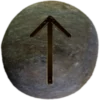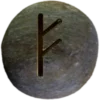Last Updated on March 23, 2025
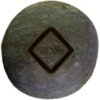
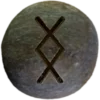
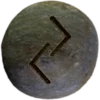
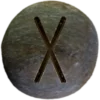
Meaning and Symbolism
The Ingwaz rune (ᛜ or ᛝ) is pronounced “ING-wahz.” Some sources spell it as Inguz. The name comes from the Proto-Germanic Inguz, linked to the god Ing. This rune has phonetic values of “ng,” like in “song.”
This rune represents fertility, growth, and stored potential. It signifies cycles of renewal and inner transformation. The shape suggests a seed, indicating contained energy ready to bloom. It also symbolizes unity, balance, and completion. Unlike other runes, Ingwaz has no reversed form. This stability reinforces its meaning of certainty and resolution.
This rune also connects to hearth and home. It represents the comfort of a safe space. Many view it as a sign of well-being and familial bonds. Some associate it with masculine energy, but its meaning extends beyond gender. Ingwaz embodies personal development and the unfolding of destiny.
Historical and Linguistic Background
The Ingwaz rune appears in inscriptions from the early Germanic tribes. It features in the Anglo-Saxon Futhorc, where it retained its “ng” phonetic value. Some rune poems reference it indirectly through themes of peace and prosperity.
The rune’s name comes from Ing, an ancient fertility figure. Some later texts equate him with the Norse god Freyr. However, Ing’s origins predate Norse mythology. Some scholars believe he was a regional deity among early Germanic peoples. ![]()
In written use, it sometimes appears doubled (ᛜᛜ or ᛝᛝ). This likely emphasized sound or meaning. The rune occasionally replaces “ng” in old inscriptions. Its unique structure made it recognizable in runestones and carvings.
Practical Uses and Modern Interpretation
Many use Ingwaz in meditation and spiritual practices. It represents new beginnings, making it popular in personal rituals. Some believe it aids inner focus and personal growth. Others see it as a rune of patience, symbolizing gradual but steady progress.
Artists and writers may use Ingwaz to enhance creativity. It signifies the gestation of ideas before expression. Some people associate it with productivity and problem-solving. Others wear or carve it to attract stability and positive change.
The Rune in Eddas and Sagas
Though Ingwaz itself is not named, Ing appears in Old English poetry. The Old English Rune Poem describes him as a traveling leader. Some scholars link this figure to Freyr, a god of fertility and abundance. However, no direct references to it exist in the Poetic or Prose Eddas.
Ingwaz symbolizes potential, transformation, and stability. It carries themes of growth, fertility, and personal evolution. Its association with the mysterious figure of Ing links it to prosperity and leadership. With its steady energy and firm meaning, It remains a powerful symbol of inner and outer development.
Runes Associated with Ingwaz
The Jēra (ᛃ) (“YAIR-ah”) and Gēbo (ᚷ) (“GAY-boh”) Elder Futhark runes connect to Ingwaz through cycles, growth, and exchange. ![]()
Jēra symbolizes harvest and time. It represents effort leading to reward as well as emphasizing the natural cycles. Both runes highlight patience and transformation.
Gēbo signifies gift-giving and balance. It reflects mutual benefit and harmony. Ingwaz shares this theme, focusing on potential and release. Both runes deal with exchange and interconnected forces.
Together, Jēra, Gēbo, and Ingwaz show how growth, cycles, and relationships shape existence. Their shared meanings provide insight into progress, cooperation, and fulfillment.
Its Power in Asatru
Ingwaz represents fertility, potential, and internal growth. Its name connects to Freyr, a Vanir god of prosperity. This rune symbolizes stored energy, waiting for the right moment to emerge.
Asatruar see Ingwaz as a rune of personal transformation. It marks the completion of cycles and the readiness for new beginnings. Many use it in rituals for inner strength and stability. It also represents the seed’s journey—hidden but full of life.
This rune holds deep ancestral meaning. It ties to kinship, inheritance, and the passing of wisdom. Ingwaz encourages patience, knowing that growth happens beneath the surface. Many Asatruar carve it into tools or jewelry for grounding and perseverance. It reminds practitioners that true strength develops internally before manifesting outwardly.

